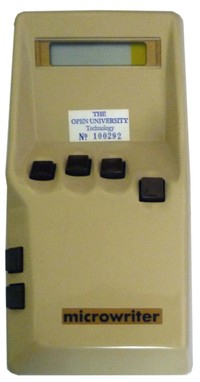Microwriter MW4
| Home > Browse Our Collection > Computers > Microwriter > Microwriter MW4 |
|
The Microwriter is a hand-held portable word-processor with a chording keyboard. It was sold in the early 1980s by Microwriter Ltd, of London, UK. Microwriter was invented by UK-based, US-born film director Cy Endfield. The Microwriter MW4 A six-button chording keyboard. The keyboard uses one button for each finger and two for the thumb of the user's right hand. The five buttons immediately beneath the fingers are pressed in different combinations to generate all letters. The second thumb button is used to toggle through a range of modes that allow the user to switch case, enter numbers, insert punctuation and even add ASCII control characters, to be used in editing the document being prepared. To type a letter "T", for example, the user would tap the top thumb button to shift to uppercase, then chord a "t" by pressing the index finger and ring finger buttons simultaneously. The manufacturers claimed that most people could learn to use it in just a couple of hours. With some practice, it is possible to become a faster typist with the Microwriter than with a conventional keyboard, providing that what is being entered is just text. Typing is slowed if a substantial number of special characters have to be entered using the "shifting" mechanism. Learning the chords for the basic letters and numbers is facilitated by a set of flash-cards that show simple mnemonics for each character. Despite a lack of similar products, the Microwriter was not a success, and ceased production in 1985. It is likely that the concept of a chording keyboard put off many potential customers. The Microwriter model DSA is to connect the microwriter to a screen or TV. This is complete with manuals, soft case and power supply unit. Manufacturer: Microwriter Comment on This Page Microwriter MW4 Manuals:
Magazines RELATED to Microwriter MW4 in our Library
Other Systems Related To Microwriter MW4:
This exhibit has a reference ID of CH5794. Please quote this reference ID in any communication with the Centre for Computing History. |
Click on the Image(s) For Detail
|














